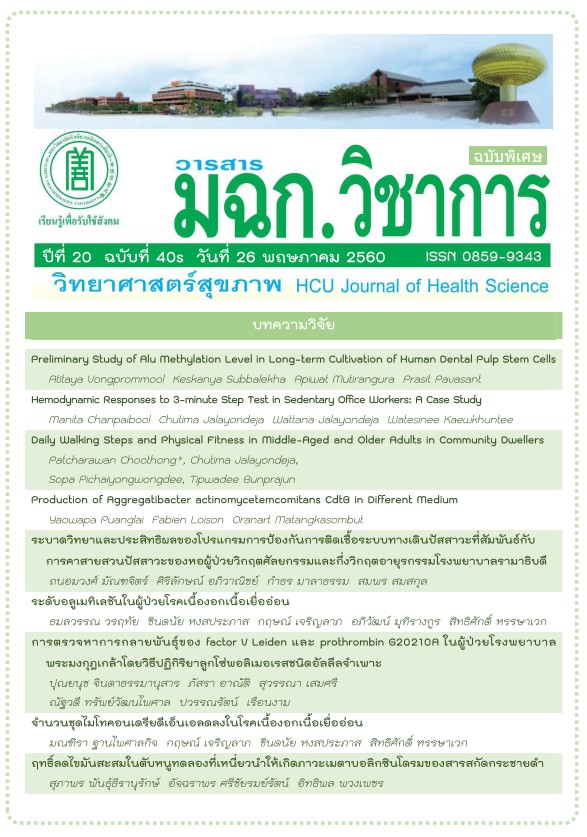Hemodynamic Responses to 3-minute Step Test in Sedentary Office Workers: A Case Study
คำสำคัญ:
Cardiorespiratory fitness, Hemodynamic responses, Office worker, Physical activity, Sedentary behaviorบทคัดย่อ
Hemodynamic responses to exercise can be an indicator of cardiorespiratory fitness (CRF) which referred to a body’s ability to supply adequate oxygen to all tissues. Behavioral factors including physical activity (PA) and sedentary behaviors (SB) influences on cardiometabolic risk factors that related to CF and hemodynamic responses. However, lack of study was conducted to measure the hemodynamic responses in those combined PA and SB. Therefore, the objective was to compare the hemodynamic responses between office workers who were in sedentary exercisers group (SEG) and couch potatoes group (CPG) at resting, exercise testing and recovery periods. A case study was conducted in office workers at Faculty of Physical Therapy, Mahidol University. The inclusion criteria were: age 20-40 years, body mass index (BMI) <30 kg/m2 and sedentary time >8 hours/day. Demographic data were age, gender, weight, height, and job description. The sedentary time and PA were measured by questionnaire of Thai Physical Activity Guideline (TPAG). Sedentary participants were classified into SEG (with physically active) and CPG (with physical inactive). The hemodynamic responses were measured by a portable transthoracic bioimpedance cardiograph device (PhysioFlow Enduro, Paris, France). They were assessed at resting for 2 minutes, exercise testing using the 3-minute step test, and minute 1, 2 and 3 of recovery period. The Mann-Whitney U test was used for data analysis. Of total 22, 8 participants aged 26-36 years, BMI 18.81-29.06 kg/m2, and sedentary times 8.5-14.0 hours/day. They were in SEG (n=5) and CPG (n=3). Similar pattern of hemodynamic responses were found in both groups at resting, exercise testing and recovery period. Significant difference of blood pressure (BP), heart rate (HR) and cardiac output (CO) (p<0.05) between SEG and CPG at exercise testing. At the recovery period, these parameters were not return to the resting period in CPG. In conclusion, PA was a dominant factor in combined behaviors and influenced on the hemodynamic responses to exercise. Therefore, encouraged PA in office workers who had sedentary time more than 8 hours per day was recommended.
Downloads
ดาวน์โหลด
เผยแพร่แล้ว
รูปแบบการอ้างอิง
ฉบับ
ประเภทบทความ
สัญญาอนุญาต
บทความที่ได้รับการตีพิมพ์เป็นลิขสิทธิ์ของวารสารวิทยาศาสตร์สุขภาพและสุขภาวะ
ข้อความที่ปรากฏในบทความแต่ละเรื่องในวารสารวิชาการเล่มนี้เป็นความคิดเห็นส่วนตัวของผู้เขียนแต่ละท่านไม่เกี่ยวข้องกับมหาวิทยาลัยหัวเฉียวเฉลิมพระเกียรติ และคณาจารย์ท่านอื่นๆในมหาวิทยาลัยฯ แต่อย่างใด ความรับผิดชอบองค์ประกอบทั้งหมดของบทความแต่ละเรื่องเป็นของผู้เขียนแต่ละท่าน หากมีความผิดพลาดใดๆ ผู้เขียนแต่ละท่านจะรับผิดชอบบทความของตนเองแต่ผู้เดียว




